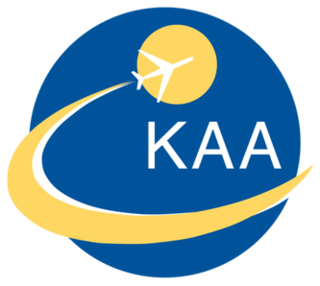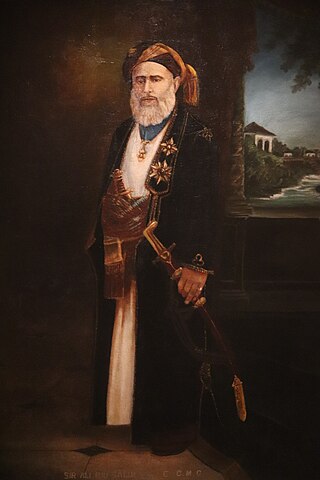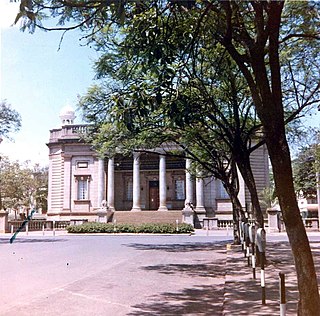
Eldoret is a city in the Rift Valley region of Kenya. It serves as the capital of Uasin Gishu County. Located in western Kenya, and lying south of the Cherangani Hills, the local elevation varies from about 2,100 metres (6,900 ft) at the Eldoret International Airport to more than 2,700 metres (8,900 ft) in nearby areas.

Nakuru is a city in the Rift Valley region of Kenya. It is the capital of Nakuru County, and it is the fourth largest city in Kenya and the largest in the Great Rift Valley, Kenya|Rift Valley region. As of 2019, Nakuru had an urban population of 570,674, making it the largest urban center in the Rift Valley, above Eldoret, Uasin Gishu County. The city lies along the Nairobi–Nakuru Highway, 160 kilometres (99 mi) from Nairobi, the capital city of Kenya.
John Joseph Njenga was a Roman Catholic prelate who was the Archbishop of the Roman Catholic Archdiocese of Mombasa from 1990 until his age-related retirement in 2005. Before that, from 1988 until 1990, he was the Bishop of Mombasa before the diocese was elevated to an archdiocese. Prior to Mombasa, he served as the Bishop of the Roman Catholic Diocese of Eldoret from 1970 until 1988. He was appointed bishop on 19 October 1970 by Pope Paul VI. He died on 4 November 2018, as the Archbishop Emeritus of Mombasa, Kenya, one month shy of his 90th birthday.
Education in Kenya refers to the institutionalised education system in Kenya, whereby pupils and students are taught in specific locations, following a particular curriculum. The institutionalised system differs from traditional education which had been in existence long before missionarisation and colonisation, and was administered according to the various indigenous groups' cultures and customs.
Kenyan Sign Language is a sign language is used by the deaf community in Kenya and Somalia. It is used by over half of Kenya's estimated 600,000 deaf population. There are some dialect differences between Kisumu, Mombasa and Somalia.
The Kenya Bureau of Standards (KEBS) is a government agency responsible for governing and maintaining the standards and practices of metrology in Kenya. It was established by an Act of Parliament of Kenya's National Assembly, The Standard Act, and Chapter 496 of the Laws of Kenya. The Bureau started its operations in July 1974. It has main offices in Nairobi and regional offices throughout Kenya.

Hinduism is a minority faith in Kenya, constituting 0.13% of the population of Kenya. Due to the efforts of the Hindu Council of Kenya, Kenya is one of only three African countries to recognise Hinduism as a religion. Hindus are free to practise their religion in Kenya, and several Kenyan cities have Hindu temples. The Hindu temples in Kenya are mostly of north and west Indian architectural style.

Kenya Airports Authority (KAA) is the owner and operator of nine civilian airports and airstrips in Kenya. Kenya Airports Authority was established by an act of Parliament in 1992, by the ruling Kenya African National Union government. The KAA Act, Cap 395, provides for the powers and functions of the Authority. Its head office is on the property of Jomo Kenyatta International Airport in Embakasi, Nairobi.

Indians in Kenya, often known as Kenyan Asians, are citizens and residents of Kenya with ancestral roots in the Indian subcontinent. Significant Indian migration to modern-day Kenya began following the creation of the British East Africa Protectorate in 1895, which had strong infrastructure links with Bombay in British India. Indians in Kenya predominantly live in the major urban areas of Nairobi and Mombasa, with a minority living in rural areas.

Jomo Kenyatta University of Agriculture and Technology (JKUAT) is a public university that is situated in Juja, 36 kilometres northeast of Nairobi, along the Nairobi-Thika SuperHighway, off Exit 15. It offers courses in Technology, Engineering, Science, Commerce, Management and Building sciences and holds a strong research interest in the areas of biotechnology and engineering. Notable alumni include Dr. Paul Chepkwony, the first governor of Kericho County in Kenya and a former lecturer, Emma Miloyo, a prominent Kenyan architect and the first female president of the Architectural Association of Kenya, as well as Aden Duale, the former Leader of Majority in the 11th Kenyan Parliament among others. As at 2023, the Vice Chancellor of the University was Prof. Victoria Ngumi.
Imperial Bank Limited commonly known as Imperial Bank, is a commercial bank in Kenya, the largest economy in the East African Community. It is one of the forty-three commercial banks licensed by the Central Bank of Kenya, the central bank and national banking regulator.
Paramount Bank, is a commercial bank in Kenya. It is one of the forty-four commercial banks licensed by the Central Bank of Kenya, the national banking regulator.

Sub-counties, formerly known as Districts, are the decentralised units through which government of Kenya provides functions and services. At national level, sub-counties take a more administrative function like security, statistical purposes, provision of government services, etc. Even though the sub-counties are divisions of counties, powers to create new national sub-counties lies with the national government. As of 2023, there are 314 sub-counties, compared to 290 constituencies. A deputy county commissioner is appointed by the state to lead each sub-county. The sub-counties are further divided into divisions, locations and sub-locations.
The following is a timeline of the history of the city of Mombasa, Coast Province, Kenya.
The Kenya–Uganda–Rwanda Petroleum Products Pipeline is a pipeline that carries refined petroleum products from the Kenyan port city of Mombasa to the country's capital of Nairobi and continues to the city of Eldoret in the Eastern Rift Valley. There are plans to extend the pipeline to Uganda's capital, Kampala, continuing on to Rwanda's capital, Kigali.
Bank of India (Kenya) is a commercial bank in Kenya. It is one of the commercial banks licensed by the Central Bank of Kenya, the national banking regulator.

Sir Ali bin Salim bin Khalfan Al Busaidi was a prominent Arab figure in the Kenyan colonial history. He is also a member of the House of Busaid that ruled East Africa in the 19th century. His father, Sayyid Salim bin Khalfan Al Busaidi, was the governor of Malindi and then transferred to Mombasa in the late 19th century. Sir Ali al-Busaidi defended the rights of the Arabs in the British colony of Kenya. He established the Seif Bin Salem Library in Mombasa. He played a leading role in establishing the first Arab school in 1912. He also founded another school His name was named in (Malindi).

The McMillan Memorial Library is a public library situated in Nairobi, Kenya. It is the oldest library in Nairobi, and the second oldest in Kenya after the Seif bin Salim Library in Mombasa.














